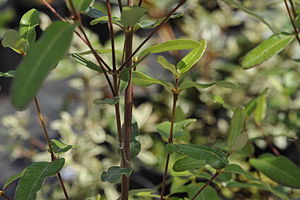Tasmanian elm elm
| Tasmanian elm elm | ||||||||||||
|---|---|---|---|---|---|---|---|---|---|---|---|---|

Tasmanian common elm ( Eucryphia lucida ) |
||||||||||||
| Systematics | ||||||||||||
|
||||||||||||
| Scientific name | ||||||||||||
| Eucryphia lucida | ||||||||||||
| Labill. & Baill. |
The Tasmanian false elm ( Eucryphia lucida ) is a tree species native to Tasmania from the genus of the false elm ( Eucryphia ) in the family Cunoniaceae . In Tasmania the tree is called Leatherwood .
Distribution and location
The Tasmanian false elm is widespread across Tasmania, but is found mainly in the west of the island, where temperate rainforest predominates. In order to thrive, the tree needs a humid, temperate climate with around 1500-2500 mm of annual precipitation and is only partially hardy in Central Europe .
Fossil plant remains from the early Pleistocene , found at Regatta Point in Tasmania, show similarities to the Tasmanian pseudo-elm.
description
The Tasmanian mock elm reaches a height of about 25 meters. With a height of 2 to 10 meters, some specimens are rather large bushes than trees.
The small, green, glossy leaves are narrow, elliptical in shape and around 2 to 4 inches long. The white flowers are about 2.5 to 4 centimeters in diameter and consist of four petals. They appear in spring to summer and give off an intense scent.
The number of chromosomes is 2n = 30.
use
- The hard wood is used to build musical instruments such as guitars.
- Bees produce honey from the nectar, which has colors from dark yellow-creamy to brown-clear. In the German Honey Ordinance, there are exceptions to the sucrose content, for example for Leatherwood honey . It can contain up to 10 g sucrose per 100 g honey.
- There are numerous crosses with other species of the mock elm that are used for agriculture.
Individual evidence
- ^ Robert S. Hill: Leaves of Eucryphia (Eucryphiaceae) from tertiary sediments in south-eastern Australia . In: Australian Systematic Botany Vol. 4 No. 3, 1991, pages 481-497.
- ↑ Eucryphia lucida at Tropicos.org. In: IPCN Chromosome Reports . Missouri Botanical Garden, St. Louis
- ↑ https://bienenkunde.uni-hohenheim.de/honigverordnung.html